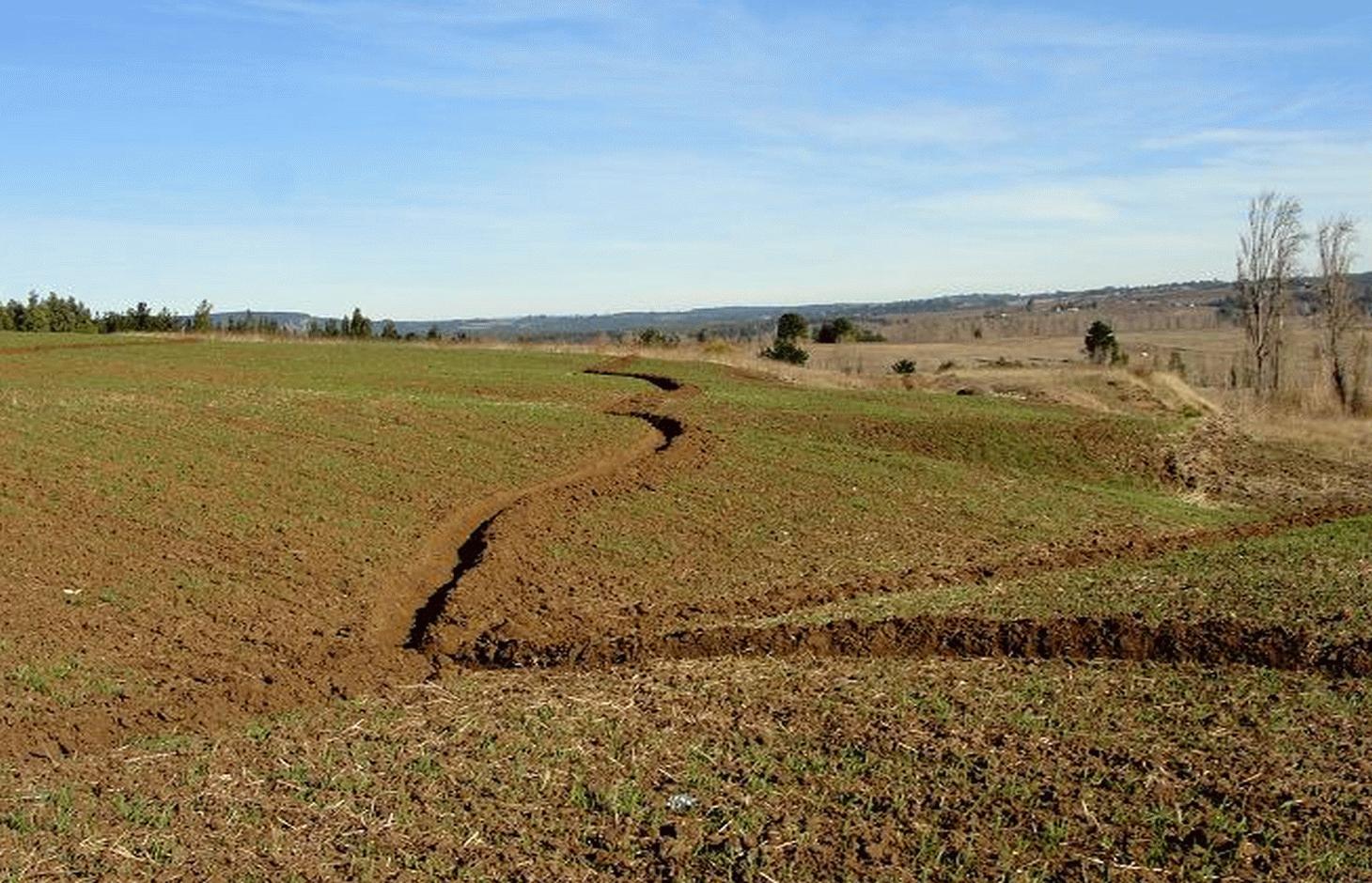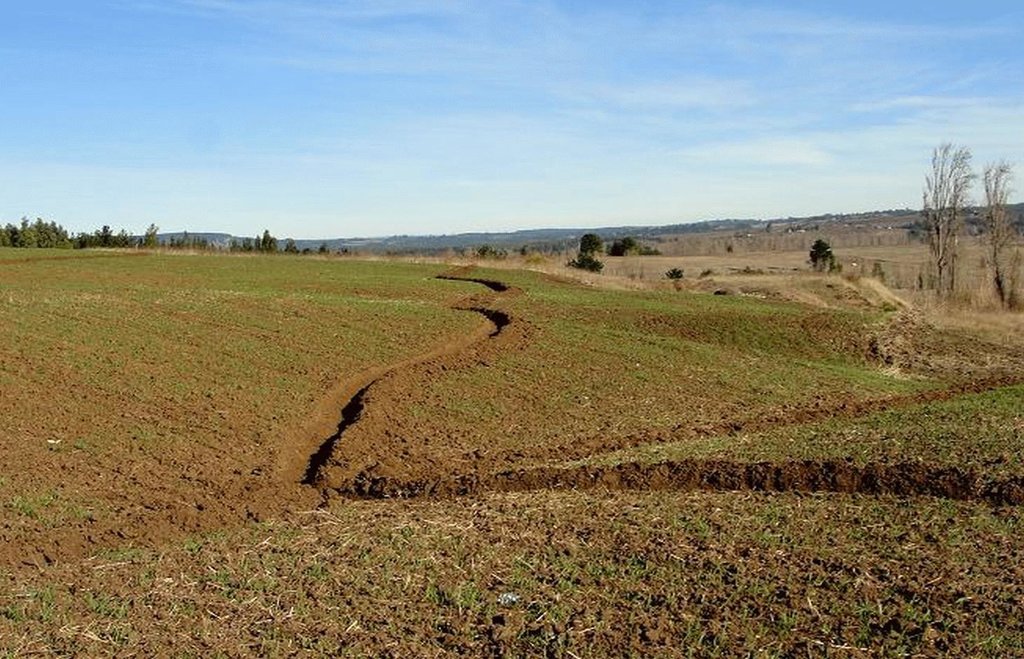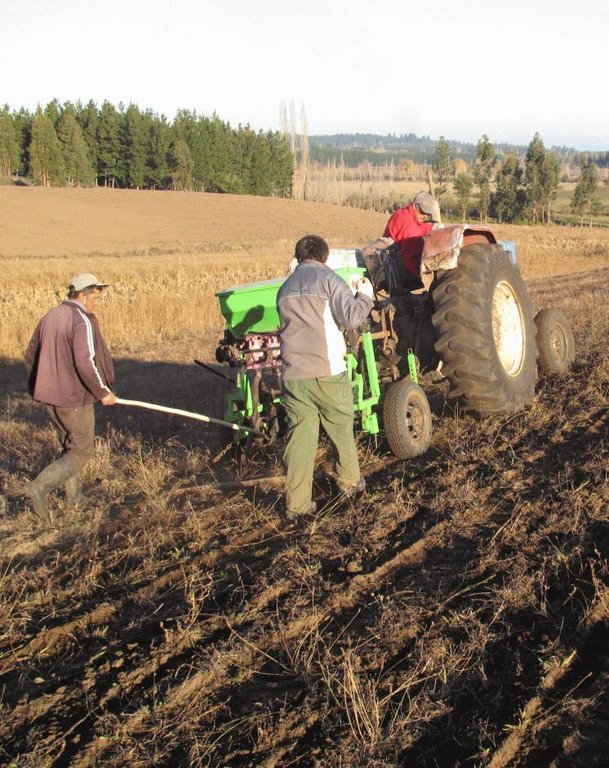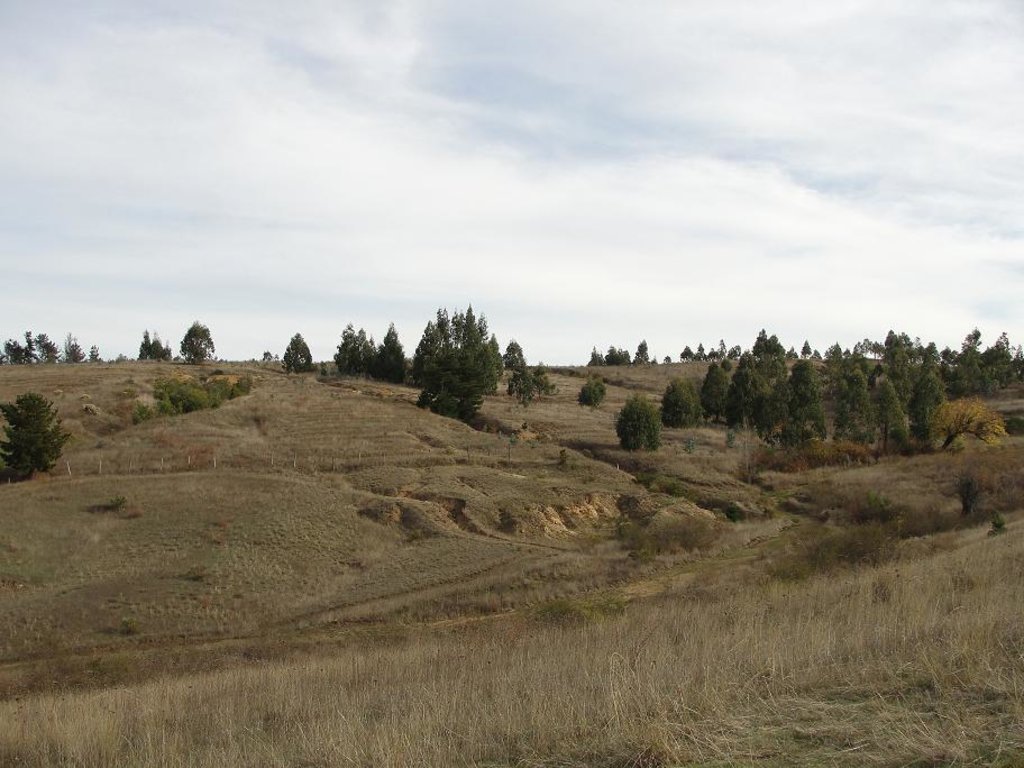Dissemination of soil conservation technologies in dryland areas [Chile]
- Creation:
- Update:
- Compiler: Carlos Ovalle
- Editor: –
- Reviewers: Fabian Ottiger, Deborah Niggli
Cero labranza con subsolado (Spanish)
approaches_2577 - Chile
View sections
Expand all Collapse all1. General information
1.2 Contact details of resource persons and institutions involved in the assessment and documentation of the Approach
Name of project which facilitated the documentation/ evaluation of the Approach (if relevant)
DESIRE (EU-DES!RE)Name of the institution(s) which facilitated the documentation/ evaluation of the Approach (if relevant)
Instituto de Investigaciones Agropecuarias (INIA) (Instituto de Investigaciones Agropecuarias (INIA)) - Chile1.3 Conditions regarding the use of data documented through WOCAT
When were the data compiled (in the field)?
11/05/2011
The compiler and key resource person(s) accept the conditions regarding the use of data documented through WOCAT:
Ja
1.4 Reference(s) to Questionnaire(s) on SLM Technologies
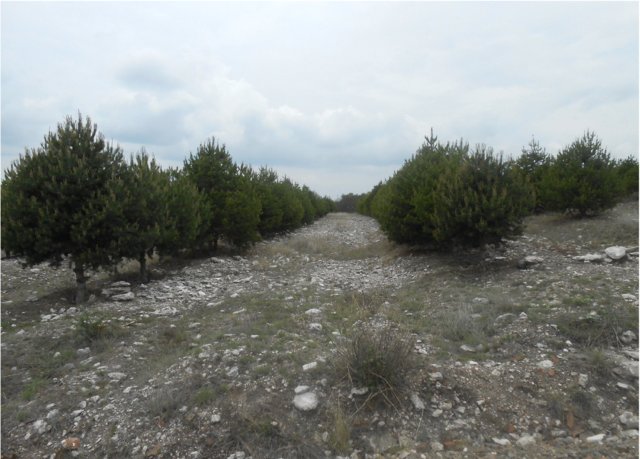
Callejones de piñón con forrajes intercalados [Mexico]
La tecnología consiste en un sistema agrosilvopastoril con árboles de Pinus cembroides (pino piñonero) alineados een bordos ─en un terreno con suelos calizos previamente subsoleado─ conformando melgas (callejones) para con cultivos anuales para grano y forraje, con pastoreo libre eventual por períodos muy breves.
- Compiler: BENJAMIN SANCHEZ BERNAL
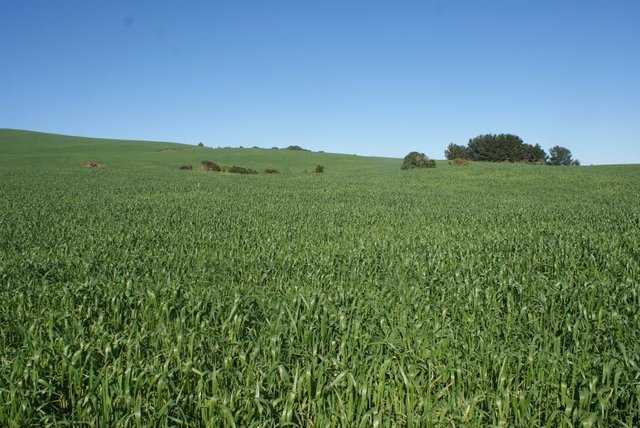
No tillage preceded by subsoiling [Chile]
No tillage preceded by subsoiling consists in the use of a subsoiler at a 50 cm depth every 5 years before performing no tillage agriculture.
- Compiler: Carlos Ovalle
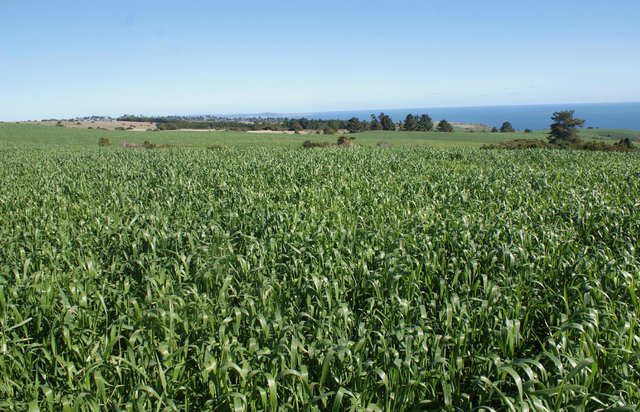
Crop rotation with legumes [Chile]
Biological Nitrogen Fixation (BNF) of legumes as a source of N in crop rotations with cereals in Mediterranean Chile
- Compiler: Carlos Ovalle
2. Description of the SLM Approach
2.1 Short description of the Approach
Dissemination of no tillage with subsoiling in the Municipality of Yumbel
2.2 Detailed description of the Approach
Detailed description of the Approach:
Aims / objectives: The Commune of Yumbel is a rural territory in the secano interior of central-south Chile, which has historically been an area of cereal crops and pulses. This has represented for many years the mainstay of the economy of small and medium farmers in the area. Owing to the sharp deterioration in the quality of the soil, caused by years of cultivation without respect for conservation, production potential was quickly fading and plunging farmers into an economic and social crisis caused by low yields and low income from agriculture. However, despite degradation, the commune still has abundant natural resources of soil and water, which will not be used by the forestry industry, and which can be recovered for productive and profitable agriculture. In May 2009, the team of researchers from INIA Quilamapu started this initiative based on promising results obtained in the EU DESIRE project for zero tillage, subsoiling and new crop rotations. The initiative was oriented towards transferring the technologies developed in DESIRE. The project received financial support from the Municipality of Yumbel.
The aim was to revitalise agriculture in the district of Yumbel, improve traditional crops using a conservation approach, which enables small- and medium-scale farmers to improve their incomes, create jobs and improve their quality of life.
Specific objectives:
• To develop new farming systems based on the application of soil conservation practices (no tillage and subsoiling) that prevent erosion, and allow the development of a more sustainable and economic agriculture.
• To improve crop rotations, introduce grain and pasture legumes to diversify production and use of nitrogen inputs for lower nitrogen fertilizer costs.
• To build-up again the production of grain legumes and cereals in the district of Yumbel
• To renew the genetic material of crop species and varieties currently available to farmers in the area, allowing access to improved varieties of higher yield potential and resistance to diseases.
Methods: We used a participatory approach, incorporating small producers in the extension programme from the beginning. Three representative areas were selected. Leader farmers were chosen in each sector who were responsible for field work. No tillage machinery was provided by INIA and acquired by a local farmer. The project directly involved 50 farmers and 250 ha of land. Further 400 farmers are being benefited by training on technologies of soil conservation and crop rotations and management.
Role of stakeholders: Municiplity of Yumbel: financing the project of technology transfer INIA and DESIRE project: human and material resources (machinery, transportation researchers, etc.). Ministry of Agriculture (INDAP, Institute of Agricultural Development): financing of management plans for soil conservation.
Technology transfer companies: technical assistance directly to the small farmers
Farmers: conducting field work and incorporating new technologies.
2.3 Photos of the Approach
2.5 Country/ region/ locations where the Approach has been applied
Country:
Chile
Region/ State/ Province:
Bíobio and Maule region
Further specification of location:
Cauquenes, Chile
Map
×2.6 Dates of initiation and termination of the Approach
Indicate year of initiation:
2007
Year of termination (if Approach is no longer applied):
2011
2.7 Type of Approach
- project/ programme based
2.8 Main aims/ objectives of the Approach
The Approach focused on SLM only
To revitalising agriculture in the district of Yumbel, improve traditional crops with a conservation approach, which enables small- and medium-scale farmers to improve their incomes, to create jobs and to improve their quality of life.
The SLM Approach addressed the following problems: 1. Lack of machinery in the area 2. Few service providers 3. Lack of technical knowledge 4. Lack of cash to invest in SLM
5. Failure to implement a subsidy programme for farmers so that they can be organized around the creation of small company of service providers of machinery for subsoiling and no-tillage sowing.
2.9 Conditions enabling or hindering implementation of the Technology/ Technologies applied under the Approach
social/ cultural/ religious norms and values
- hindering
The traditional farming system. Farmers have used the mouldboard plough as the primary tillage implement.
Treatment through the SLM Approach: Showing in farm days, the excellent results obtained in the experimental sites with no tillage and new crop rotation.
availability/ access to financial resources and services
- hindering
Lack of capital and financial resources of the farmers.
Treatment through the SLM Approach: State instruments and aids to implement soil conservation plans in the fields of the producers.
institutional setting
- hindering
Absence or lack of coordination between institutions responsible for rural development.
Treatment through the SLM Approach: Implementation of a participatory rural development project for soil conservation and improvement of agriculture, inspired by the methodologies and experience of the project.
knowledge about SLM, access to technical support
- hindering
Lack of knowledge on sustainable farming practices.
Treatment through the SLM Approach: Implementation of a soil conservation programme under the real conditions of the farmers with an environmental and economic sustainability approach.
3. Participation and roles of stakeholders involved
3.1 Stakeholders involved in the Approach and their roles
- local land users/ local communities
Men are more involved in tillage activities. Men perform hard labour job in the land, while women participate in household tasks.
- SLM specialists/ agricultural advisers
INIA
- teachers/ school children/ students
Universidad de Concepción, Universidad de Talca
- national government (planners, decision-makers)
INIA, SAG
- international organization
3.2 Involvement of local land users/ local communities in the different phases of the Approach
| Involvement of local land users/ local communities | Specify who was involved and describe activities | |
|---|---|---|
| initiation/ motivation | self-mobilization | The producers themselves and the municipality of Yumbel demanded the project implementation given the severe problems of rural poverty and the soil degradation |
| planning | interactive | The technologies are being applied and implementation has been made through interaction with farmers, municipalities, INIA and INDAP |
| implementation | interactive | The farmers implemented the conservation practice in their lands. |
| monitoring/ evaluation | interactive | Researchers evaluated this results |
| Research | interactive |
3.4 Decision-making on the selection of SLM Technology/ Technologies
Specify who decided on the selection of the Technology/ Technologies to be implemented:
- mainly SLM specialists, following consultation with land users
Explain:
Decisions on the method of implementing the SLM Technology were made by mainly by SLM specialists with consultation of land users
4. Technical support, capacity building, and knowledge management
4.1 Capacity building/ training
Was training provided to land users/ other stakeholders?
Ja
Specify who was trained:
- land users
- field staff/ advisers
Form of training:
- on-the-job
- farmer-to-farmer
- demonstration areas
- public meetings
- courses
4.2 Advisory service
Do land users have access to an advisory service?
Ja
Describe/ comments:
Advisory service is very adequate to ensure the continuation of land conservation activities
4.3 Institution strengthening (organizational development)
Have institutions been established or strengthened through the Approach?
- yes, moderately
Specify the level(s) at which institutions have been strengthened or established:
- local
Give further details:
The Yumbel project has had permanent participation of INIA (project DESIRE) and INDAP.
4.4 Monitoring and evaluation
Is monitoring and evaluation part of the Approach?
Ja
Comments:
bio-physical aspects were monitored by project staff through measurements; indicators: Soil fertility (soil nutrient content N, P, K, S), erosion (soil loss, loss of nutrients), quality of soil (compaction, bulk density, structure, aggregate stability)
economic / production aspects were monitored by project staff through observations; indicators: Crop production (yield, quality), gross margin, profitability
There were no changes in the Approach as a result of monitoring and evaluation
There were no changes in the Technology as a result of monitoring and evaluation
4.5 Research
Was research part of the Approach?
Ja
Specify topics:
- technology
Give further details and indicate who did the research:
There are three experimental sites with evaluations to determine the best choice of conservation tillage systems and crop rotations. Different conservation tillage systems were evaluated and compared to conventional tillage. On these experimental sites, several indicators (chemical, physical and biological) were evaluated.
Research was carried out both on station and on-farm
5. Financing and external material support
5.1 Annual budget for the SLM component of the Approach
If precise annual budget is not known, indicate range:
- 10,000-100,000
Comments (e.g. main sources of funding/ major donors):
Approach costs were met by the following donors: international: 30.0%; government: 70.0%
5.2 Financial/ material support provided to land users
Did land users receive financial/ material support for implementing the Technology/ Technologies?
Ja
If yes, specify type(s) of support, conditions, and provider(s):
INDAP (Institute of Agricultural Development)
5.3 Subsidies for specific inputs (including labour)
If labour by land users was a substantial input, was it:
- voluntary
Comments:
Between INIA and Municipality of Yumbel a participative project wiht the local farmers was realized, to realize conservation tillage system.
The funding for the implementation of new technologies are 50% from the state (programme of recovery of degraded soils of the Government of Chile for soil conservation practices) and 50% of the producers themselves (materials, labour, etc.).
5.4 Credit
Was credit provided under the Approach for SLM activities?
Ja
Specify conditions (interest rate, payback, etc.):
repayment conditions: The funding for the implementation of new technologies are 50% from the state (programme of recovery of degraded soils of the Government of Chile for soil conservation practices) and 50% of the producers themselves (materials, labour, etc.).
6. Impact analysis and concluding statements
6.1 Impacts of the Approach
Did the Approach help land users to implement and maintain SLM Technologies?
- No
- Yes, little
- Yes, moderately
- Yes, greatly
Mitigation of water erosion effects and better yields.
Did the Approach empower socially and economically disadvantaged groups?
- No
- Yes, little
- Yes, moderately
- Yes, greatly
This programme targets small farmers of the commune, who have no access to the technology or to State aid. The results are highly promising regarding the incorporation to the development of this sector.
Did other land users / projects adopt the Approach?
- No
- Yes, little
- Yes, moderately
- Yes, greatly
Because of the great results obtained by few farmers, the approach is being adopted by others.
Did the Approach lead to improved livelihoods / human well-being?
- No
- Yes, little
- Yes, moderately
- Yes, greatly
Farmers that perform conservation obtained better yields, less work on the sowing and more time to attend to other activities on the land.
Did the Approach help to alleviate poverty?
- No
- Yes, little
- Yes, moderately
- Yes, greatly
The improvement in yields and profitability of crops, the diversification of the production and the mitigation of land degradation are the strategies that are being implemented to alleviate poverty.
6.2 Main motivation of land users to implement SLM
- increased production
- increased profit(ability), improved cost-benefit-ratio
- reduced workload
- payments/ subsidies
- rules and regulations (fines)/ enforcement
- prestige, social pressure/ social cohesion
- affiliation to movement/ project/ group/ networks
- aesthetic improvement
6.3 Sustainability of Approach activities
Can the land users sustain what has been implemented through the Approach (without external support)?
- uncertain
6.4 Strengths/ advantages of the Approach
| Strengths/ advantages/ opportunities in the compiler’s or other key resource person’s view |
|---|
| Assistance programmes from the State oriented towards tackling soil degradation. (How to sustain/ enhance this strength: This project has been sustained over time and will remain at least for 3 to 4 years.) |
| High rural population in this commune, involvement of young farmers (under 40 years) |
| A strong commitment from the local authorities with the project. |
| Great interest of farmers to improve their incomes and conditions of life. |
6.5 Weaknesses/ disadvantages of the Approach and ways of overcoming them
| Weaknesses/ disadvantages/ risks in the compiler’s or other key resource person’s view | How can they be overcome? |
|---|---|
| Lack of no-tillage machinery | Organization of associative farmers enterprises for the purchase of machinery and agricultural implements. |
| Insufficient training on soil conservation for the farmers or for technical assistance companies. | Training, field days, demonstrative sowings, explanatory publications, practical work with farmers and technicians. |
| Delay in allocation of resources of the instruments of the state. | Synchronizing the availability of resources with the needs of the farmers for the execution of the work (supply purchases, rental equipment, etc.) |
7. References and links
7.1 Methods/ sources of information
- field visits, field surveys
- interviews with land users
7.3 Links to relevant information which is available online
Title/ description:
DESIRE site information
URL:
www.desire-his.eu/en/secano-interior-chile
Links and modules
Expand all Collapse allLinks

Callejones de piñón con forrajes intercalados [Mexico]
La tecnología consiste en un sistema agrosilvopastoril con árboles de Pinus cembroides (pino piñonero) alineados een bordos ─en un terreno con suelos calizos previamente subsoleado─ conformando melgas (callejones) para con cultivos anuales para grano y forraje, con pastoreo libre eventual por períodos muy breves.
- Compiler: BENJAMIN SANCHEZ BERNAL

No tillage preceded by subsoiling [Chile]
No tillage preceded by subsoiling consists in the use of a subsoiler at a 50 cm depth every 5 years before performing no tillage agriculture.
- Compiler: Carlos Ovalle

Crop rotation with legumes [Chile]
Biological Nitrogen Fixation (BNF) of legumes as a source of N in crop rotations with cereals in Mediterranean Chile
- Compiler: Carlos Ovalle
Modules
No modules


